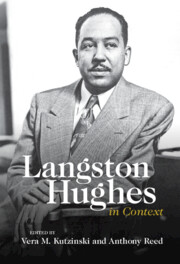Book contents
- Langston Hughes in Context
- Langston Hughes in Context
- Copyright page
- Contents
- Contributors
- Abbreviations
- Introduction
- Part I Singing America
- Chapter 1 Langston Hughes, Chicago, and Modernism
- Chapter 2 Jazz, Performance, and Modernist Embodiment in Langston Hughes’s Early Writing
- Chapter 3 His Ways with White Folks
- Chapter 4 Love at a Distance in Selected Letters by Langston and Carrie Hughes
- Chapter 5 Langston Hughes’s 1930s Short Fiction
- Chapter 6 Langston Hughes and Simple
- Chapter 7 Langston Hughes’s Famous Books, Ebony Magazine, and the Politics of Civil Rights in Biographies for the Young
- Chapter 8 Rural Black Masculinity and the Blues in Not without Laughter
- Chapter 9 From the Sublime to the Grotesque
- Chapter 10 Coalitional Aesthetics
- Chapter 11 Langston Hughes’s Translingual Poetics and Pedagogy
- Part II The Global Langston Hughes
- Part III Afterlives
- Index
Chapter 10 - Coalitional Aesthetics
Langston Hughes and the Carmel John Reed Club
from Part I - Singing America
Published online by Cambridge University Press: 10 November 2022
- Langston Hughes in Context
- Langston Hughes in Context
- Copyright page
- Contents
- Contributors
- Abbreviations
- Introduction
- Part I Singing America
- Chapter 1 Langston Hughes, Chicago, and Modernism
- Chapter 2 Jazz, Performance, and Modernist Embodiment in Langston Hughes’s Early Writing
- Chapter 3 His Ways with White Folks
- Chapter 4 Love at a Distance in Selected Letters by Langston and Carrie Hughes
- Chapter 5 Langston Hughes’s 1930s Short Fiction
- Chapter 6 Langston Hughes and Simple
- Chapter 7 Langston Hughes’s Famous Books, Ebony Magazine, and the Politics of Civil Rights in Biographies for the Young
- Chapter 8 Rural Black Masculinity and the Blues in Not without Laughter
- Chapter 9 From the Sublime to the Grotesque
- Chapter 10 Coalitional Aesthetics
- Chapter 11 Langston Hughes’s Translingual Poetics and Pedagogy
- Part II The Global Langston Hughes
- Part III Afterlives
- Index
Summary
Langston Hughes spent a year in Carmel, California, beginning at the culmination of his round-the-world trip in 1933 and ending with his fleeing for fear of vigilante violence in the summer of 1934. During this time, he became increasingly involved in the Carmel John Reed Club (JRC), in part through his relationship with Ella Winter, with whom he wrote a play based on a local cotton strike, Blood on the Fields. He published his poem “Wait” (1934) in the West Coast JRC organ, The Partisan. This chapter argues that the work Hughes produced through his affiliation with the JRC displays a “coalitional aesthetics” that reflects the organizational mode of the clubs themselves. By addressing the specific labor concerns of the San Joaquin Valley alongside those of other regions, states, nations, and continents, it simultaneously focuses on both the molar and the molecular, ultimately enacting – at the level of form – coalitional networks of solidarity that cut across racial and geographic designations.
- Type
- Chapter
- Information
- Langston Hughes in Context , pp. 104 - 114Publisher: Cambridge University PressPrint publication year: 2022

